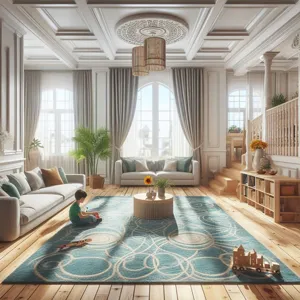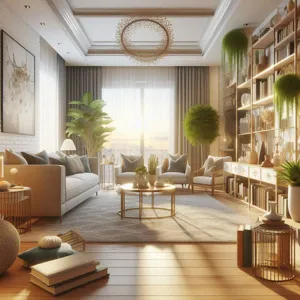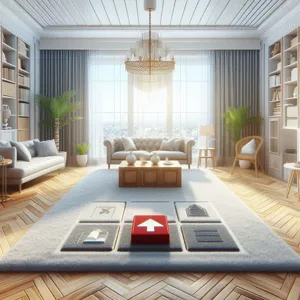When it comes to choosing the perfect carpet for your home, understanding the various types of carpet fibers is essential to making an informed decision.
Each fiber comes with its own unique properties, advantages, and drawbacks, influencing not just the look and feel of your space, but also its durability, maintenance requirements, and overall comfort. From the luxurious softness of wool to the resilience of nylon, the choices can be overwhelming. This comprehensive guide will unravel the complexities of carpet fibers, exploring the characteristics of natural and synthetic options alike. Whether you’re looking to create a cozy retreat in your living room, a stain-resistant sanctuary in your dining area, or a plush paradise in your bedroom, we’ll help you decode the nuances of carpet fibers so you can select the ideal flooring that meets your aesthetic and practical needs. Get ready to step into the world of carpets and discover how the right fiber can transform your space!
1. Introduction to Carpet Fibers: Why They Matter

Carpet fibers are the unsung heroes of your home décor, playing a pivotal role in not only the aesthetic appeal of your space but also in its comfort and functionality. From the moment you step onto a plush, inviting carpet, the type of fiber beneath your feet shapes your experience. Understanding the various types of carpet fibers available can empower you to make informed decisions, ensuring your choice aligns with your lifestyle, design preferences, and durability needs.
Different fibers offer distinct benefits and drawbacks. For instance, natural fibers like wool exude warmth and luxury, while synthetic options such as nylon and polyester provide resilience and easy maintenance. The fiber you choose can influence everything from the carpet’s texture and appearance to its stain resistance and longevity.
Moreover, the right carpet fiber can enhance your home’s energy efficiency, contribute to a healthier indoor environment, and even affect your household’s air quality. With such significant implications, it’s essential to delve into the diverse world of carpet fibers. This guide will help you decode the various types, exploring their unique properties, advantages, and ideal use cases, allowing you to elevate your living spaces with confidence and style. Whether you’re renovating a cozy den, designing a sophisticated office, or selecting the perfect carpet for your busy family home, understanding fibers will help you create a space that is not only beautiful but also tailored to your everyday needs.
2. Overview of Common Carpet Fiber Types
When it comes to selecting the perfect carpet for your space, understanding the different fiber types is crucial. Each fiber possesses its own unique properties, making it suitable for various applications and lifestyles. Here’s a closer look at the most common carpet fiber types and what sets them apart.
**1. Nylon:**
Nylon is often hailed as the gold standard in carpet fibers. Renowned for its durability and resilience, nylon carpets can withstand heavy foot traffic, making them an ideal choice for busy households or commercial spaces. Additionally, nylon has excellent stain resistance, especially when treated with soil-repellent technology. Its ability to hold vibrant colors means that nylon carpets come in a wide array of styles and patterns, ensuring you won’t compromise on aesthetics.
**2. Polyester:**
Polyester carpets are celebrated for their luxurious feel and vibrant colors. Soft and plush, polyester fibers are naturally stain-resistant and offer a degree of fade resistance, making them a popular choice for residential areas. However, while they provide great comfort, polyester tends to be less durable than nylon, which makes them better suited for low to medium traffic areas, such as bedrooms or formal living rooms.
**3. Olefin (Polypropylene):**
Olefin is a synthetic fiber known for its exceptional resistance to moisture and mildew, making it a fantastic option for areas prone to spills or moisture, such as basements or outdoor settings. It’s lightweight and often less expensive than nylon and polyester, but while it holds color well, it can be less resilient to heavy foot traffic and may crush more easily over time.
**4. Wool:**
Wool carpets are the epitome of luxury. Natural and biodegradable, wool fibers boast an unmatched softness and warmth, providing a cozy feel underfoot. They are inherently stain-resistant due to their natural oils and can absorb moisture without feeling wet, which helps in maintaining air quality. However, wool tends to be more expensive and requires more maintenance, making it suitable for those willing to invest in quality.
**5. Acrylic:**
Acrylic carpets are often designed to mimic the look and feel of wool but come with a more budget-friendly price tag. They are soft, resistant to fading, and easy to clean, making them a practical choice for families with children or pets. However, like polyester, their durability may not match that of nylon, so they are best suited for low to moderate traffic areas.
In summary, each carpet fiber type offers distinct advantages and considerations. When choosing the right carpet for your space, consider factors such as foot traffic, maintenance, and your personal style preferences. By understanding the unique properties of these fibers, you’ll be better equipped to select a carpet that not only enhances your home but also stands the test of time.
3. Nylon: The Durable Workhorse

Nylon carpets are often hailed as the durable workhorses of the flooring world, and for good reason. This synthetic fiber, first introduced to the market in the late 1930s, has since evolved into one of the most popular carpet materials available today. Its remarkable resilience and versatility make it an ideal choice for high-traffic areas in both residential and commercial settings.
One of the standout properties of nylon is its incredible strength. Known for its ability to withstand wear and tear, nylon carpets can endure the daily hustle and bustle of busy households with pets and children, as well as the heavy foot traffic of office environments. This durability translates into longevity, meaning your investment in nylon carpeting is likely to pay off over the years.
In addition to its robust nature, nylon offers a level of stain resistance that is hard to beat. Many nylon carpets are treated with stain-resistant coatings, making spills and mishaps easier to clean up without leaving a lasting mark. Whether it’s muddy paw prints or an accidental glass of wine, nylon fibers can often be cleaned with little more than soap and water, allowing you to maintain your carpet’s pristine appearance.
Moreover, nylon is available in a wide range of colors and textures, from plush to looped styles, making it a versatile option that can fit any aesthetic. Whether you prefer a cozy, inviting look for a living room or a sleek, professional appearance for an office, nylon can deliver. Its ability to hold dye exceptionally well means that you can enjoy vibrant, rich colors that won’t fade over time.
However, while nylon carpets are known for their durability, they do require a bit of maintenance to keep them looking their best. Regular vacuuming and periodic professional cleaning will help to remove dirt and restore the fibers’ natural luster. Additionally, nylon can be susceptible to static electricity, particularly in dry environments, so you may want to consider treatments or additives that can help mitigate this issue.
In summary, if you’re searching for a carpet that combines durability, stain resistance, and a wide variety of design options, nylon may just be the ideal choice for your space. Its reputation as a reliable workhorse in the carpet industry is well-deserved, making it a favorite among homeowners and businesses alike.
4. Polyester: The Eco-Friendly Choice
When it comes to eco-friendly flooring options, polyester stands out as a remarkable choice for both the environment and your home. Crafted primarily from recycled plastics, such as PET (polyethylene terephthalate) bottles, polyester carpets not only help reduce landfill waste but also offer a sustainable alternative to traditional carpet fibers. This innovative material embodies a unique blend of style and functionality, making it increasingly popular among environmentally-conscious consumers.
One of the most appealing aspects of polyester is its vibrant color retention. The dyeing process utilized in polyester production allows for rich, vivid hues that resist fading, ensuring that your carpet maintains its fresh appearance over time. Whether you’re looking for bold and bright patterns or sophisticated neutral tones, polyester carpets offer a wide range of aesthetic options to suit any decor.
In addition to their visual appeal, polyester carpets are known for their soft, luxurious feel underfoot, providing a cozy ambiance in any room. This fiber is particularly comfortable for those who enjoy the warmth of plush carpeting, making it a favorite choice for family rooms, bedrooms, and play areas. Moreover, polyester has inherent stain-resistant properties, making it an excellent option for households with children or pets. Spills can be easily blotted away, reducing the chance of permanent stains and ensuring your carpet remains looking pristine.
However, it’s essential to note that while polyester is an eco-friendly choice, it may not be as durable as some other fibers, such as nylon or wool. It can be more susceptible to wear and tear in high-traffic areas, so careful consideration of placement is advised. With proper care and maintenance, though, polyester carpets can still provide years of comfort and beauty.
In summary, polyester carpets offer an eco-friendly option that doesn’t compromise on style or comfort. By choosing this sustainable fiber, you can create a beautiful living space while making a positive impact on the environment. Whether you’re redesigning your home or simply looking to refresh your space, polyester is a fantastic choice that aligns with modern eco-conscious values.
5. Olefin (Polypropylene): The Stain-Resistant Option

Olefin, also known as polypropylene, is an increasingly popular choice in the world of carpet fibers, particularly for those seeking a stain-resistant option that doesn’t compromise on style or comfort. This synthetic fiber is renowned for its ability to repel moisture and resist staining, making it a practical choice for high-traffic areas, homes with children and pets, or any space prone to spills and messes.
One of the standout features of olefin is its inherent stain resistance. Unlike natural fibers that can absorb liquids and become discolored, olefin fibers are designed to resist staining agents, allowing you to clean up spills more easily. Whether it’s a splash of juice or a stray pet accident, most stains can be swiftly wiped away without leaving a trace, which is a significant advantage for busy households.
In addition to its stain-fighting abilities, olefin is also highly durable. It holds up well under pressure, making it an ideal choice for areas like living rooms and hallways that experience heavy foot traffic. The fiber’s resilience means it retains its shape and appearance over time, ensuring your carpet continues to look fresh and inviting.
Furthermore, olefin is a great eco-friendly option as it’s often made from recycled materials. This not only helps reduce environmental impact but also gives consumers peace of mind knowing they are making a sustainable choice. Plus, it is resistant to fading, so it maintains its vibrant colors even in sunlit rooms.
While olefin boasts many strengths, it’s worth noting that it can sometimes feel less luxurious underfoot compared to natural fibers like wool. However, modern advancements in carpet technology have led to softer olefin options that mimic the plush feel of more expensive fibers.
In summary, if you’re in search of a carpet fiber that combines stain resistance, durability, and eco-friendliness, olefin is a commendable choice. Its practical benefits make it an appealing option for families, while its modern designs ensure that your space remains stylish and inviting. Whether you’re redecorating your home or simply looking for a reliable flooring solution, olefin carpets provide a perfect blend of functionality and aesthetic appeal.
6. Wool: The Natural Luxury Fiber
Wool is often hailed as the natural luxury fiber, and for good reason. Its unique properties not only make it an excellent choice for carpets but also elevate the overall aesthetic and comfort of any space. Sourced from the fleece of sheep, wool is renowned for its softness, resilience, and superior insulating qualities. The fibers are naturally crimped, allowing them to spring back into shape after being compressed, which contributes to the durability of wool carpets and their ability to withstand heavy foot traffic.
One of the standout features of wool is its breathability. Unlike synthetic fibers, wool can effectively regulate temperature and moisture, ensuring that your home remains comfortable throughout the seasons. This natural fiber also boasts an inherent resistance to dirt and stains, thanks to its protective outer layer known as the cuticle. As a result, wool carpets are less likely to attract dust and allergens, making them an excellent option for those with sensitivities or allergies.
In terms of aesthetics, wool offers a rich palette of colors and textures, allowing homeowners to find the perfect match for their interior design. The dyeing process for wool fibers results in vibrant, long-lasting colors that maintain their brilliance over time. Furthermore, the natural sheen of wool adds an air of elegance and sophistication to any room, making it a popular choice for luxury settings.
Caring for wool carpets is straightforward, as regular vacuuming and periodic professional cleaning will keep them looking their best. While wool may come with a higher upfront cost compared to synthetic options, the long-lasting performance and timeless beauty it provides often make it a worthwhile investment. Whether you’re looking to enhance a cozy living room or create a welcoming entryway, wool carpets bring a touch of natural luxury that is hard to replicate with any other fiber.
7. Acrylic: The Affordable Alternative to Wool

When it comes to carpet fibers, acrylic stands out as an economical alternative to the luxurious softness of wool. Often hailed as the “synthetic wool,” acrylic mimics the plush feel and aesthetic appeal of natural fibers without the hefty price tag. This affordability makes it an attractive option for homeowners looking to enhance their living spaces without breaking the bank.
Acrylic carpets exhibit a remarkable range of colors and patterns, making them perfectly versatile for various decor styles. Their dye-ability allows for vibrant hues that can maintain their brilliance over time, resisting fading from sunlight or regular wear. The fiber’s inherent resistance to moisture also means that acrylic carpets are less likely to develop mildew or mold, making them suitable for high-humidity areas like basements or bathrooms.
In addition to their aesthetic advantages, acrylic fibers are notably lightweight and easy to clean. They can be vacuumed and spot-cleaned effortlessly, requiring less maintenance than some of their natural counterparts. This makes them an appealing choice for busy households, especially those with children or pets.
However, it’s worth mentioning that while acrylic carpets boast many benefits, they do have some drawbacks. They are less durable than wool and may not withstand heavy foot traffic as well, making them better suited to low-traffic areas such as bedrooms or offices. Moreover, acrylic is more prone to static electricity, which can be a consideration in certain environments.
In summary, acrylic carpets provide an excellent balance of affordability, style, and ease of care, making them a fantastic option for budget-conscious homeowners seeking the elegance of wool without the associated costs. Whether you’re revamping a cozy nook or outfitting a larger space, acrylic can deliver the comfort and visual appeal you desire.
8. Blends: Combining Fibers for Enhanced Performance
When it comes to carpet fibers, blends offer a fascinating approach that combines the best characteristics of different materials to create products that excel in both performance and aesthetics. By merging various fibers, manufacturers can enhance durability, comfort, and style, resulting in carpets that cater to diverse needs and preferences.
One popular example is the combination of nylon and polyester. Nylon, renowned for its resilience and ability to withstand heavy foot traffic, pairs seamlessly with polyester, which provides a soft feel and vibrant color retention. This blend creates carpets that are not only durable but also luxuriously soft underfoot, making them an ideal choice for family rooms or bedrooms where comfort is paramount.
Another common blend includes wool and synthetic fibers. Wool brings natural beauty and superior insulation properties, while synthetics can offer added strength and stain resistance. This combination allows homeowners to enjoy the timeless elegance of wool, along with the practical benefits of synthetic materials, resulting in carpets that are both stylish and functional.
Blends can also be tailored to specific environments. For instance, in commercial settings, carpets made from a mix of polypropylene and nylon can withstand heavy use while remaining easy to clean and maintain. These blends often feature antimicrobial treatments, ensuring a hygienic space that can handle the rigors of busy workplaces.
In summary, opting for blended fibers in your carpet choice allows you to leverage the unique properties of different materials. Whether you’re seeking durability, comfort, or aesthetics, blends provide a versatile solution that can elevate your space while catering to your specific lifestyle needs. As you explore your options, consider how a carefully curated blend can enhance both the look and functionality of your flooring.
9. Understanding Fiber Density and Pile Height
When it comes to carpets, two critical factors that significantly influence their appearance, durability, and comfort are fiber density and pile height. Understanding these elements can help you make informed decisions when selecting the perfect carpet for your home or office.
**Fiber Density** refers to the amount of fiber used in a given area of the carpet. Higher density indicates that more fibers are packed into each square inch, which translates to a more robust and resilient carpet. Dense carpets not only feel plush underfoot, but they also resist crushing and matting over time, making them ideal for high-traffic areas. On the other hand, carpets with lower fiber density may feel softer initially but are more susceptible to wear and tear, leading to a shorter lifespan.
**Pile Height**, on the other hand, refers to the length of the carpet fibers. Carpets can be categorized into three primary pile height groups: low, medium, and high. Low pile carpets, typically measuring under 1/4 inch, are easy to clean and maintain, making them an excellent choice for busy households or commercial spaces. They also work well with furniture, as they won’t crush easily. Medium pile carpets, around 1/4 to 1/2 inch in height, strike a balance between comfort and practicality, offering a cozy feel while still being reasonably durable. High pile carpets, which exceed 1/2 inch, provide the ultimate softness and luxury, creating a warm and inviting atmosphere. However, they can be more challenging to clean and may not withstand heavy foot traffic as well as their lower-pile counterparts.
When considering a new carpet, it’s essential to assess both fiber density and pile height in relation to your lifestyle and the specific needs of the space. A high-density, low-pile carpet might be perfect for a family with children and pets, while a plush, high-pile option could enhance the comfort and aesthetics of a cozy living room. By understanding these factors, you can choose a carpet that not only complements your decor but also stands the test of time, ensuring your investment pays off in both style and durability.
10. The Importance of Fiber Twist and Construction
When it comes to the world of carpets, the twist and construction of fibers play a pivotal role in determining not only the aesthetic appeal but also the functionality and durability of the flooring. Fiber twist refers to the tightness and number of turns in a fiber strand, which fundamentally affects the carpet’s texture, resilience, and appearance over time. A higher twist level typically results in a denser and more durable carpet, as tightly twisted fibers are less prone to matting and crushing. This makes them an excellent choice for high-traffic areas in your home, such as living rooms and hallways.
In addition to twist, the construction of the carpet—how the fibers are woven or tufted together—further influences its performance characteristics. Carpets can be looped, cut, or a combination of both, each offering distinct benefits. Loop pile carpets, for instance, provide excellent durability and are less likely to show footprints or vacuum marks, making them a practical choice for busy households. On the other hand, cut pile carpets deliver a softer and more luxurious feel underfoot, ideal for creating inviting spaces in bedrooms or formal living areas.
Understanding the importance of fiber twist and construction not only helps in choosing the right carpet for your needs but also informs decisions regarding maintenance and longevity. Carpets with higher twist levels and robust construction are typically easier to clean and maintain, as they resist dirt accumulation and wear. So, whether you’re revamping a cozy nook or outfitting the entire home, paying attention to these factors will ensure you invest in a carpet that offers beauty, comfort, and lasting performance.
11. Comparing Durability and Maintenance Requirements
When it comes to selecting the perfect carpet for your space, understanding the durability and maintenance requirements of different carpet fibers is essential. This comparison will not only help you make an informed decision but also ensure that your investment stands the test of time while remaining beautiful and functional.
**Nylon**, often hailed as the workhorse of carpet fibers, boasts exceptional durability. It is resistant to wear and tear, making it an excellent choice for high-traffic areas. However, its maintenance is straightforward; regular vacuuming and periodic deep cleaning will keep it looking fresh. Nylon does have a tendency to fade in direct sunlight, so consider using window treatments to mitigate this effect if your carpet is in a sun-drenched area.
**Polyester**, known for its vibrant colors and luxurious feel, is another popular option. While it offers good resistance to stains, it may not be as durable as nylon, especially in homes with pets or heavy foot traffic. Maintenance for polyester is relatively easy, but it tends to attract dirt and may require more frequent vacuuming to maintain its appearance. Additionally, it can mat down over time, especially in heavily used spaces, so regular rotation of furniture can help minimize wear patterns.
For those seeking eco-friendly options, **wool** stands out as a natural fiber that combines durability with a plush feel. Wool is inherently resilient and can bounce back from compression, making it suitable for both medium and high-traffic areas. However, it does require more maintenance than synthetic fibers. Regular vacuuming and periodic professional cleaning are recommended to avoid dirt buildup and to preserve its natural oils, which protect against staining and soiling.
**Olefin (Polypropylene)** is often used in outdoor and indoor/outdoor carpets due to its excellent resistance to moisture and mildew. While it may not be as durable as nylon or wool, it is stain-resistant and easy to clean, making it a practical choice for areas prone to spills. Regular sweeping and occasional rinsing with water can keep olefin carpets looking their best, but be aware that they can fade in direct sunlight over time.
Ultimately, the decision regarding durability and maintenance should align with your lifestyle and the specific needs of your space. By comparing these fiber types, you can select a carpet that not only enhances the aesthetics of your home but also meets your practical requirements for longevity and ease of care.
12. Environmental Impact of Different Carpet Fibers
When selecting the perfect carpet for your home or office, it’s essential to consider not only the aesthetic appeal and durability of the fibers but also their environmental impact. As awareness of sustainability grows, consumers are increasingly eager to understand how their choices affect the planet. Different carpet fibers vary significantly in their ecological footprint, and being informed can help you make responsible decisions.
**Natural Fibers**: Wool, cotton, and sisal are some of the most common natural fibers used in carpets. Wool, in particular, is highly regarded for its renewable properties; sheep produce new fleeces annually, making it a sustainable choice. Additionally, wool carpets are biodegradable, breaking down naturally without leaving harmful residues. However, it’s worth noting that the farming practices for wool can vary, and some may not adhere to environmentally friendly standards. Cotton, while soft and comfortable, often requires large amounts of water and pesticides in its cultivation, which can diminish its eco-friendliness. Sisal, derived from the agave plant, is a strong and durable option, but its production can lead to soil degradation if not managed sustainably.
**Synthetic Fibers**: On the other hand, synthetic fibers like nylon, polyester, and polypropylene come with their own set of environmental concerns. These materials are often derived from petrochemicals, contributing to fossil fuel depletion and increasing greenhouse gas emissions. While nylon carpets are known for their durability and stain resistance, they can take hundreds of years to decompose in landfills. Polyester, often made from recycled plastic bottles, offers a more sustainable option, but its production process is energy-intensive. Polypropylene is less harmful in terms of VOC emissions but is still derived from non-renewable resources.
**Recycling and End-of-Life Options**: The environmental impact of carpet fibers doesn’t end at installation. It’s crucial to consider how carpets are disposed of at the end of their life cycle. Many manufacturers now offer recycling programs, allowing consumers to return their old carpets for processing. This not only reduces landfill waste but also contributes to a circular economy. Choosing carpets made from recyclable materials or those that can be easily repurposed can significantly lower your overall environmental footprint.
In conclusion, understanding the environmental impact of different carpet fibers is vital for making informed choices. By considering the source, production methods, and disposal options, you can select a carpet that not only enhances your space but also aligns with your values of sustainability and environmental responsibility. With this knowledge in hand, you can enjoy your beautiful flooring while contributing positively to the planet.
13. Tips for Choosing the Right Carpet Fiber for Your Space
Choosing the right carpet fiber for your space can feel like an overwhelming task, especially with the myriad of options available. Each fiber comes with its own set of characteristics, making it crucial to consider how these traits will align with your lifestyle, aesthetic preferences, and the specific demands of your environment. Here are some valuable tips to guide you through the selection process:
1. **Assess Your Lifestyle**: Start by evaluating your daily life. Do you have young children or pets that might bring in dirt or spills? In this case, durable fibers like nylon or polyester may be your best bet, as they are known for their resilience and ease of cleaning. On the other hand, if your space is more formal and you entertain guests often, luxurious options like wool can add a touch of elegance and comfort.
2. **Consider Foot Traffic**: The amount of foot traffic in a room significantly impacts the choice of carpet fiber. High-traffic areas, such as hallways and living rooms, require harder-wearing materials. Nylon, for example, is highly resistant to wear and tear, making it ideal for such spaces. In contrast, a low-traffic area like a guest bedroom could benefit from the softness of wool or the plush feel of frieze.
3. **Evaluate Maintenance Needs**: Different carpet fibers come with varying maintenance requirements. Wool, while luxurious, tends to require more upkeep compared to synthetic fibers. Consider how much time and effort you’re willing to invest in cleaning and maintenance. If you prefer a low-maintenance option, look for stain-resistant materials and those that can withstand regular vacuuming and occasional deep cleaning.
4. **Think About Allergies and Sensitivities**: If you or your family members suffer from allergies, opt for hypoallergenic options. Natural fibers like wool can help regulate indoor air quality and resist dust mites, but they may not suit everyone. In such cases, synthetic fibers designed to minimize allergens could be a better choice.
5. **Match Fiber to Room Functionality**: Each room serves a different purpose, and the carpet’s fiber should complement that. For instance, in a home office, a low-pile nylon carpet can provide both comfort and practicality, allowing for easy rolling of office chairs. In a cozy den, a plush, high-pile option can enhance warmth and comfort, inviting relaxation.
6. **Color and Style Considerations**: Finally, don’t forget about aesthetics. The color and texture of your chosen fiber should harmonize with your overall decor. Lighter shades can create an airy feel, while darker tones can add drama and warmth. Additionally, consider patterns and textures that can enhance the visual interest of your space.
By carefully considering these factors, you can select the carpet fiber that not only meets your practical needs but also elevates the beauty of your home. Remember, the right carpet fiber is an investment in both comfort and style, so take the time to make an informed choice that will serve you well for years to come.
14. Common Misconceptions About Carpet Fibers
When it comes to carpet fibers, misconceptions abound, often leading homeowners astray in their purchasing decisions. One prevalent myth is that all synthetic fibers are inferior to natural ones. While it’s true that natural fibers like wool boast remarkable durability and luxurious texture, modern synthetic options—such as nylon and polyester—offer exceptional resilience, stain resistance, and ease of maintenance. Many consumers overlook these advancements, mistakenly believing that only natural fibers can provide the quality they desire.
Another common misconception is that high-pile carpets are always the most comfortable. While plush, high-pile carpets do provide a cozy feel underfoot, they can also trap dirt and allergens more easily than low-pile options. This can lead to a less hygienic environment, especially for allergy sufferers. In contrast, low-pile carpets tend to be easier to clean and maintain, offering comfort without compromising health.
Additionally, many people assume that the color and pattern of a carpet are the most critical factors in their choice. However, the fiber type plays an equally important role in the longevity and performance of the carpet. For instance, while a vibrant, patterned carpet can enhance a room’s aesthetic, it may not wear as well under heavy foot traffic if made from a less durable fiber.
Finally, there’s the myth that all carpet fibers are created equal when it comes to environmental impact. In reality, the source and production methods of fibers vary significantly. Natural fibers like wool are often more sustainable and biodegradable than synthetic alternatives, which can contribute to environmental waste. On the other hand, some synthetic fibers are now being produced from recycled materials, presenting an eco-friendly option that challenges the traditional view of synthetic carpets.
Understanding these misconceptions is crucial for anyone considering a new carpet. By educating yourself about the true properties and performance of different carpet fibers, you can make informed choices that enhance both the style and functionality of your living space.
15. Conclusion: Making an Informed Decision on Carpet Fibers
In conclusion, selecting the right carpet fiber is a pivotal decision that can dramatically influence both the aesthetics and functionality of your space. As we have explored throughout this guide, each type of carpet fiber—be it nylon, polyester, wool, or olefin—boasts its own unique properties, advantages, and drawbacks. Understanding these distinctions allows you to align your choice with not only your style preferences but also your lifestyle and specific needs.
For instance, if durability and stain resistance are at the top of your list, nylon might be your go-to option, proving to be resilient even in the busiest of households. Conversely, if sustainability and natural beauty are your priorities, wool offers an eco-friendly choice that adds warmth and elegance to any room. Additionally, knowing how different fibers react to wear, cleaning methods, and environmental factors can help you make a choice that stands the test of time.
As you embark on your carpet selection journey, take the time to assess the space you’re carpeting, the foot traffic it will experience, and the overall aesthetic you wish to achieve. Don’t hesitate to seek samples, consult with professionals, and gather insights from those who have walked the path before you. Ultimately, an informed decision will not only enhance your home’s comfort and style but also provide you with a flooring solution that enhances your living environment for years to come.
As we conclude our comprehensive guide to decoding carpet fibers, we hope you now feel empowered to make informed decisions about your flooring choices. Understanding the unique properties of different carpet fibers—whether it’s the luxurious softness of wool, the durability of nylon, or the stain resistance of polyester—can significantly impact both the aesthetic and functional aspects of your home. By considering factors such as foot traffic, maintenance needs, and your personal style, you can choose the perfect carpet that not only enhances your living space but also complements your lifestyle. We encourage you to revisit this guide whenever you’re ready to elevate your interiors with the right carpet. Happy decorating, and may your floors always feel as good as they look!




